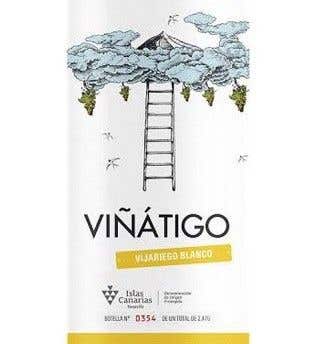From 19.40 Swiss francs, £20.09, $24.99
Last month I found myself in New York reading Cork Dork, that ripper of a read so enthusiastically reviewed by Tam recently. The protagonist spends time working in New York’s awesome Terroir wine bar and I made it my business to spend some of my own time sitting at the same bar, eating and drinking whatever came my way and reading the hugely entertaining wine list cover to cover like a book. My discovery wine was Viñátigo’s Vijariego Blanco from the Ycoden-Daute-Isora appellation in the north of the island of Tenerife, in Spain’s Canary Islands.
Before you wince at the thought of wine produced on an island best known (in the UK, anyway) for cheap package holidays, think of the Canary Islands as you might Greece or Portugal; undergoing a vinous renaissance, thanks to both significant local and EU investment and the current (literal) thirst for unknown, indigenous grape varieties that have lain quietly dormant for decades while Chardonnay & Co took over the world.
The comparison doesn’t end there. My immediate impression of the Vijariego Blanco was ‘it’s a less lemony Assyrtiko’. It had the same bracing acidity as the Greek variety and was similarly zesty, tangy and saline. It actually tastes as though it were grown by the sea. Like Assyrtiko, Vijariego Blanco retains acidity despite sky-high temperatures, without developing sky-high alcohol (although this wine is still 13.5%). It was deliciously rich in flavour and exceedingly thirst-quenching. In a word, yum.
The vineyards lie at varying elevations on sloping volcanic soils, low in fertility and well-draining – perfect for viticulture. Grapes are hand-picked and re-sorted at the gravity-fed winery that is naturally cooled by its stone walls. Winemaking is cool and reductive – apparently so reductive that no added sulphur is required for the prevention of oxidation – ‘natural’ wine lovers take note. The wine is fermented in French oak for six months, with some lees stirring, then spends a few months in stainless-steel tanks before settling and bottling.
On the label, the rungs of the ladder represent the terraced vineyards that ascend the slopes of Tenerife’s Teide volcano towards el mar de nube, the Magic-Faraway-Tree-esque sea of clouds that float in from the Azores and sit atop the Teide, keeping the south of the island so much drier than the north.
The great vine killer phylloxera – which wiped out so many of the vines of Europe in the 19th century, forcing a replanting of whatever was most popular or economic at the time – never hit the Canary Islands, presumably due to both its isolation and the phylloxera-unfriendly volcanic soils. As such, the islands are a veritable gold mine of old vines of ancient, unique grape varieties.
Viñátigo’s passionate and pioneering director Juan Jesús Méndez Siverio – also known as ‘Dr Grape’ – has been working tirelessly since the mid 1990s to identify and revive production of these ancient grape varieties of Tenerife. In collaboration with a number of universities and research institutes too lengthy to list, he has thus far identified 82 (!) grape varieties and how best to grow and vinify each. Many of these long-forgotten varieties have since been planted at Viñátigo and produce varietal wines such as this Vijariego Blanco.
Wine-Searcher lists UK stockists Noel Young Wines, Great Wines Direct and Corking Wines, USA retailer Dion’s Fine Wines, and others in mainland Europe. The wine is imported into Germany by 5515 Genussraum, into the USA by David Bowler Wine, into the UK by Hallgarten and into Belgium by La Buena Vida. The producer tells me it is widely available in Spain (although Wine-Searcher doesn’t say so) and Spaniards can also buy (minimum order six bottles) direct from the Viñátigo website, which is the cheapest option (€102.22 per six bottles, including delivery) but they have already moved on to the brand-new 2017 vintage, which I haven't yet tasted.
